Looking to get your first guitar? There’s a huge range of stringed instruments out there, and the sheer number of types can sometimes baffle a beginner, which is why we’ve put together this handy guide to the different types of guitar you might encounter!
From the elegant and reposed steel-string dreadnoughts to the super-sleek heavy metal machines, we’ll help you identify the perfect instrument for you in this in-depth guide.
In a nutshell
The main types of guitars you’ll find are:
- Acoustic
- Electro-Acoustic
- Electric
- Bass
- Classical
Beyond these are a few related folk types that fall outside the popular categories:
- Resonators
- Ukuleles
- Mandolins
- Banjos
Types of guitar – what are they?
Classical guitars
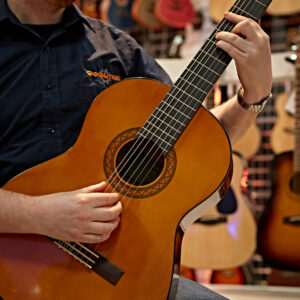 Good for beginners? Yes
Good for beginners? Yes
Genres: Classical, Jazz, Folk, Pop
From the fluid motion of flamenco music to the sweeping scores of classical orchestras, the classical guitar is renowned for its responsive fingerpicking styles and warm nylon sound.
Generally, (emphasis on generally) classical guitars are smaller than most other acoustics, leading to a bright tone that helps individually plucked notes stand out above a mix.
They can be made from a variety of materials and will almost always feature nylon strings. These strings are much easier to fret than their steel counterparts and are less taxing on soft hands that aren’t yet covered in callouses.
Plus, they’re paired with wide, flat radius fretboards to make fingerstyle licks even easier as it gives your hand loads of room to press down each note.
Additionally, there’s a large range of scaled-down classical guitars out there that accommodate younger students who would struggle with full-size instruments. This page is a great starting point for the budding musician, with plenty of slighter instruments suited to those just starting out.
As for playability, they can be used for strumming chords and genres outside of classical, but their lack of mid-range and low-end punch can make other acoustics better suited to singer-songwriters.
And if you’re looking for a great all-rounder classical to begin with, the Deluxe Cutaway Classical Electro Guitar by Gear4Music covers all the bases. It’s full size, has a cutaway neck to help you reach the high frets, and has integrated electronics to make performing and recording a breeze.
Altogether, a classical guitar’s comfortable nylon strings, small size, and wide, flat fretboard make them a superb starting point for inexperienced players. And there’s a huge range of inexpensive, beginner-focused instruments out there to choose from.
Shop now | Classical guitars
Steel-string acoustics
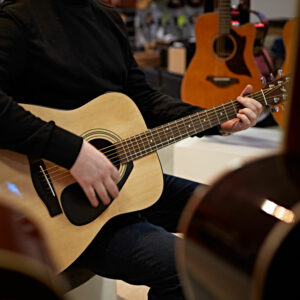 Good for beginners? Yes
Good for beginners? Yes
Genres: Classical, Rock, Folk, Country, Pop, Bluegrass, Blues, Jazz
Mention the word “acoustic” and most people will think of the classic dreadnought style guitar. And that’s because steel strings have dominated much of popular music for well over a century, evolving with the times to suit each new generation of players.
Steel-string acoustics cover a wide variety of guitar shapes and dimensions, which can heavily impact the type of sound they produce. The aforementioned dreadnought style is the most well-known and boasts a powerful voice with plenty of volume and character thanks to its larger profile.
Originally developed by Martin in the 1930s, it’s proven to be one of the most popular six strings for decades. Other shapes include the large and chord-friendly jumbo, skinny and bright parlour, and the bigger-than-parlour-but-smaller-than-dreadnought in-betweeny shaped concert.
Steel-string acoustics can be made from a huge variety of tonewoods which have a strong influence on their resulting sound. By far the most common combinations you’ll see are mahogany or rosewood back and sides matched with a spruce top.
In addition, you’ll see references to either solid or laminate woods. Solid wood guitars are generally more expensive due to the higher material cost and the fact that the tone of solid wood improves over time. Laminate, on the other hand, is cheaper and more durable thanks to its glued construction – ideal for beginners travelling to lessons and recitals!
Steel-string guitars’ balanced tones typically make them a favourite of singer-songwriters, who can strum detailed and full-bodied chords to sing over the top of. And whether you’re an artist-to-be or a blues brother in waiting, the Yamaha F310 is an excellent starting point. It boasts an impressive voice and enough versatility to handle both chords and fingerpicked licks.
Shop now | Acoustic guitars
Resonator guitars
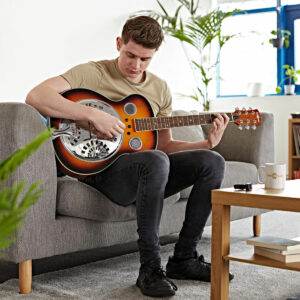 Good for beginners? Yes
Good for beginners? Yes
Genres: Folk, Country, Blues, Bluegrass
An often-overlooked instrument for newcomers to the guitar, resonators fill a sonic niche with their distinctive style and twangy sound. Their funky design and metallic construction originated in the 1920s when wooden acoustic guitars just couldn’t compete against the horns and percussion of big bands.
To solve this noisy quandary, an inventor named John Dopyera founded a company and the first resonator guitar. The resonator differed from traditional acoustics by using a metal bridge and “resonator cones” in place of a wooden soundboard, achieving much greater volume and a distinctive treble tone.
After leaving his first company, John Dopyera later founded Dobro to continue making resonators. The name stuck, and today Dobro is often shorthand for a resonator, a term you’ll often encounter when looking at various models!
Speaking of models, resonators come in two main varieties: round-necked and flat/square-necked. Round-necked resonators can be played just like your standard acoustic guitar, operating with the same standard E tuning – just with the entrancing metallic sound. Square-necked resonators can only be played flat on your lap due to their neck shape and very high nut and string action.
So, what about their genres? Well, lap steel guitars are pretty much exclusively used for slide playing in country and bluegrass styles. As for round necks, you’ll typically find them in country, bluegrass, and blues too, but their standard guitar action makes them more versatile at branching out into other genres.
The Hartwood Renaissance Resonator is an excellent starting point for any curious guitarist. It has quality appointments like a bone nut, steel alloy construction, and a biscuit-style resonator to give a sparkling, twangy tone.
Shop now | Resonator guitars
Electro-acoustic guitars
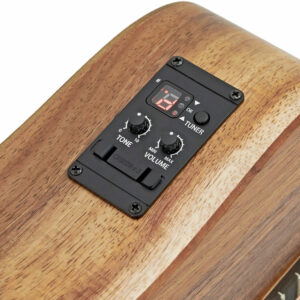 Good for beginners? Yes
Good for beginners? Yes
Genres: Classical, Rock, Folk, Country, Pop, Bluegrass, Blues, Jazz
Get louder. Electro-acoustic guitars are exactly the same as your standard acoustic but with one crucial addition – they offer the ability to plug into amplifiers to get much more volume.
This solves the problem of using microphones to amplify your acoustic, which isn’t always practical or easy to do. It also makes electro-acoustics ideal for gigging and recording musicians as it allows them to plug into a PA system, DI, or amplifier to carry their sound for an entire audience.
How do they work? Electro acoustics feature a pickup and a preamp to translate your tone to electronic signals.
The pickup is responsible for capturing the sound of your acoustic, while the preamp allows you to shape your sound with an EQ.
Pickups come in three main varieties, each offering a different style of sound:
- Piezo: A strip of magnets underneath the saddle or bridge
- Microphone: A small microphone mounted inside the guitar
- Soundhole mounted: A flat pickup mounted across the soundhole, similar to a solid body electric guitar
Most electro acoustics use the piezo style as it’s neat, unobtrusive, and less prone to feedback. But as with normal acoustics, the price range of electros can vary massively, from beginner-focused value instruments to ultra-expensive luthier crafts with cutting-edge electronics.
This wide spectrum of available electros means that they’re good for any player, regardless of ability level. In fact, many have onboard tuners, reducing hassle for both beginners and performers.
If you’re after an instrument with a bold voice and rookie-friendly electronics, the Sigma GJME Grand Jumbo Electro Acoustic is one to check out. With a jumbo-style body for plenty of volume and tonal depth and Sigma’s easy-to-use electronics, it can make a room rock whether it’s plugged in or not!
Shop now | Electro acoustic guitars
Semi-hollow or hollow-body guitars
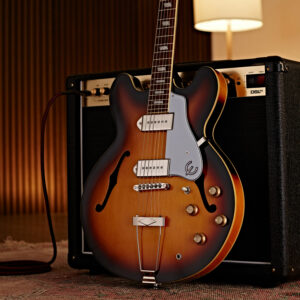 Good for beginners? Yes
Good for beginners? Yes
Genres: Jazz, Blues, Rock, Pop
Halfway between an acoustic and solid-body electric guitar, semi and fully hollow-body guitars feature large, elegantly curved bodies with resonant sound chambers and electric guitar-style pickups.
Recognisable features on both semi and fully hollow-body guitars are F holes, an archtop body, and adjustable tailpieces.
Semi-hollow vs. hollow-body
As the name suggests, hollow-body instruments are almost completely hollow, allowing for larger, full-bodied tones with exceptional clarity and a rich acoustic character. This makes them well-suited to clean jazz and blues genres.
One problem the fully hollow body can encounter is feedback at higher volumes, which can distort or ruin its pristine sound. This is solved by the semi-hollow design, which has a centre block running through the middle to cancel out feedback, letting them achieve higher levels of gain for crunchy and distorted tones.
Consequently, the sonically flexible semi-hollow is the more popular design as it can adapt to modern rock, blues, and pop with a clearer sound. BB King’s Lucille ES-355 stands tall as one of the most iconic archtop semi-hollow guitars – so iconic it was stolen several times!
As for fully hollow, John Lennon’s Epiphone Casino remains one of the most sought-after models, with a thinline construction to reduce feedback and for an utterly distinctive style.
The Epiphone ES-339 is a great starting point if you like the archtop aesthetic and rich tonality. With its semi-hollow build and powerful humbucker pickups, it has the clarity for clean jazz, classic crunch for blues, and higher output capability for rock ‘n’ roll.
Shop now | Semi acoustic and hollow-body guitars
Solid body electric guitars
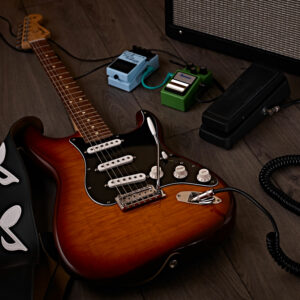 Good for beginners? Yes
Good for beginners? Yes
Genres: Rock, Country, Metal, Blues, Jazz, Pop, Electronica
Emblematic of music in the 20th century, solid body electrics are what most people would identify as “rock”.
From Jimi Hendrix in the ’60s to the virtuosic Polyphia of today, generations of famous artists have wielded solid body electrics. Not only did they play them, but they’ve also pushed the boundaries of genres to the point where you’ll find an electric guitar involved in many modern forms of music.
In contrast to acoustics and hollow-body electrics, solid body electrics derive most of their tone from the pickups. These block-like magnets cover each of the strings and come in many different varieties, which heavily influence the kind of tone you can expect to get.
Alongside pickups, the neck shape will vary depending on the type of guitar you’re looking at. Shredder guitars aimed at faced-paced metalheads have super thin necks for speedy solos, whereas larger jazz instruments feature thicker necks for easier chording.
As for the sounds? The sky’s the limit! Because these produce an electric signal, you can easily modify your tone with effect pedals to produce anything from gentle overdrives to completely alien digital delays and reverbs.
The Fender Stratocaster is perhaps one of the most famous guitars in all of existence, and this Vintera ’60s model captures the essence of the earliest versions. With a cool period appearance and sparkling, glassy tones, this is the quintessential guitar for rock, blues, and beyond.
Bass guitars
 Good for beginners? Yes
Good for beginners? Yes
Take an electric guitar, make it a bit longer, make the strings a whole lot thicker, and you’ve got yourself a bass! The electric bass guitar was invented by Leo Fender in the ’50s, and like the electric guitar, it solved the problem of the acoustic double bass being drowned out by a band.
Acoustic basses still exist, but are primarily used for jazz or stripped-back acoustic pop. Electrics are by far the most common though, as you’ve got much more flexibility in using your instrument and the kind of tone you can project.
Like electric guitars, electric basses feature pickups to capture and shape the sound. And also like electric guitars, these can range from lower output vintage-style pickups to thicker and heavy high-output humbuckers for crunchier and more aggressive harmonics.
If you see yourself as a rhythm machine, the bass could be your calling! Most of the time, a bassist works in the background to provide the low-end heft and body to a piece of music. But with funky slap styles, modern bassists often find themselves taking a lead role in ensembles too!
The Fender Player Precision Bass (often referred to as a ‘P bass’) is one of the most iconic 4-string instruments out there. Easy to play thanks to its single split-coil pickup, this buttercream bass can handle any kind of classic genre you’d like, from disco to indie rock. It’s a great all-rounder choice.
If you want something with a bit more thump for heavier styles, the Ibanez SRMD200D boasts two pickups for extended frequencies and a much more affordable price point for newer players looking for their first bass!
Shop now | Bass guitars
7-string guitars
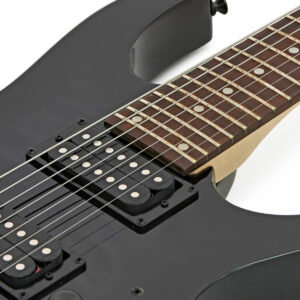 Good for beginners? No
Good for beginners? No
Genres: Metal, metal, and more metal. Also jazz and jazz fusion occasionally
Extend your range! 7-string guitars feature an extra low B string to widen the range of available frequencies the guitar can produce. They let you plunge your sound into thunderous bass-y depths, which makes them well-suited to heavy genres like metal.
These styles tend to rely on dark tones and booming rhythms, so the additional low end can give your ferocious chugs extra menace. And for other genres? Jazz and jazz fusion can also make use of the wider sonic range of the 7-string, creating interesting chord shapes and richer bass rhythms.
The most common 7-string guitars you’ll see are designed with metal in mind, which is why they’ll have sleek bodies usually equipped with humbucking pickups. In addition, they tend to sport thin, slender necks to accommodate the extra string.
Speaking of their necks, extended-range guitars (ones with more than 6 strings) will often have multi-scale fretboards. This means the frets are slanted instead of straight, letting your hand rest in a more natural position for firing out quick and speedy solos.
Is 7 the limit? No! You can get both 8 and 9-stringed guitars to really push your tone low. These instruments are usually reserved for super technical virtuoso players, so if you’re the type of player who loves to push the boundaries of musical complexity, these are for you!
Looking for a 7-string to get you started? The Ibanez GRG7221QA GIO is a sturdy, well-made instrument with powerful, metal-ready pickups. Together with a string-thru bridge to keep tuning stable and a 5-way selector for a wide range of tones, it’s a super choice for budding metalheads.
Shop now | 7-string guitars
12-string acoustics
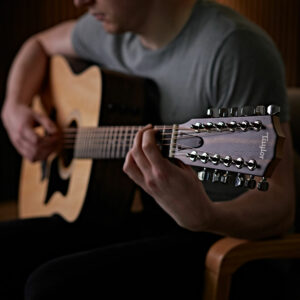 Good for beginners? No
Good for beginners? No
Genres: Folk, Country, Blues, Rock
Producing a sparkling and beautiful octaval sound, 12-string acoustics are behind some truly iconic songs. “Hotel California”, “A Horse with No Name”, and “Wanted Dead or Alive” are just a few legendary tracks which feature the dozen-stringed instrument.
So what’s the point in having double the amount of strings? Isn’t it a bit excessive? Well, no, because the strings are laid out in pairs, meaning you treat each couple as one string. So, how you play the guitar doesn’t change, but the sound does! That’s because each extra string is tuned an octave apart in pitch.
This creates a sweet, dynamically rich effect which can turn even basic chords into majestically sweeping sounds. And if that’s the case, then why aren’t 12-strings recommended for beginners? Well, to accommodate those extra strings and tension, the neck needs to be wider and fatter. This can be awkward to navigate for a player who hasn’t yet built their fretting hand strength.
On top of that, your maintenance tasks are doubled – you’ve got twelve strings to replace with each restringing instead of six, and that large change in tension often means the neck will need adjusting to keep the playing action consistent.
But despite all that, if the allure of the harmonically lush 12-string has you captivated, the Fender CD-140SCE is a guitar that offers an entrancing sound without being too expensive. It has a cutaway body to grant you easy access to the upper frets and built-in electronics to simplify recording and live shows.
Shop now | 12-string acoustic guitars
Ukulele
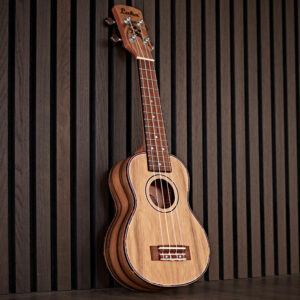 Good for beginners? Yes
Good for beginners? Yes
Genres: Pop, Rock, Jazz, Blues
Small, sonically bright, and enormously fun to play, the ukulele welcomes both novice musicians and professional guitarists alike. They come in many shapes and sizes, but the overriding theme is a small guitar shape, usually with 4-strings, and a lively treble sound.
Originating in Europe, but strongly associated with the pacific paradise of Hawaii, the ukulele has come to represent white sand beaches, crystal blue ocean waters, and lazy afternoon luaus. It’s an instrument that has discovered a resurgence in popularity for its affordability, ease of playability, and social media potential.
While it wasn’t invented in Hawaii, it certainly was adopted by it! The locals were so impressed by a travelling Portuguese musician’s small guitar and rapid playability that they named it ukulele, which translates to “jumping flea”. It was so successful that even the Hawaiian monarch learned to play!
How are they built? Pretty much like scaled-down acoustic guitars. They feature a range of tonewoods, with cheaper ukes bearing laminate/plastic construction, and more expensive models boasting solid woods.
Just like the materials, the shape can vary to create different sounds. Sopranos are the most common and have a super bright voice. Next up are concert styles, which are a little bigger and darker in tone. Tenor ukes have a longer scale length and use a tuning similar to guitars, and baritones have an even longer scale length to produce an extended bass range.
In general, ukes are great for beginners thanks to their low cost, simplicity, and sing-along potential. The Luna Vintage Concert Uke is larger than a soprano, affording you with a few more tonal options. It also offers built-in electronics to take that gentle treble-rich voice to the stage and beyond.
Shop now | Ukuleles
Weird electrics
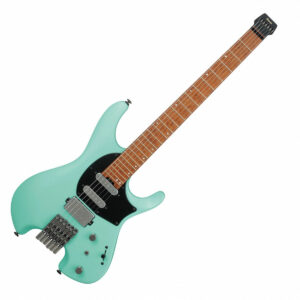 Good for beginners? No
Good for beginners? No
Genres: Classic Rock, all kinds of metal, jazz, heavier metal, jazz fusion, and did we mention metal?
So, what do we mean by weird guitars? We’ve lumped together a few different instruments that are wonderful mutations from the standard six-string layout. These include:
- Double-necked guitars
- Extended range & multi-scales
- Headless guitars
- Baritone
Each of these oddities serves a specific musical purpose and features interesting and distinctive designs to help achieve that.
Double-necked guitars (as rocked by Led Zeppelin guitarist Jimmy Page) basically fuse a 12-string and a normal 6-string into one instrument. Consequently, you get both an enveloping octaval charm and a standard electric guitar chop to call upon at the same time. They aren’t for the faint of heart though, as they’re a bit heavy and cumbersome to play!
Extended range and multi-scales call back to the 7-strings we mentioned earlier and basically give you more low-end frequencies to explore. They’re great for heavy styles and creative virtuosos looking to make full use of the fretboard.
Headless guitars like the Ibanez Q series are where it gets even weirder. They might look like they’ve fallen afoul of a French revolutionary mob, but slicing off the headstock can make a lot of musical sense.
It replaces the traditional ‘nut’ with a ‘zero fret’, meaning all your notes are fretted, just as if you were playing with a capo! This means your open-to-fretted note transitions are smooth, in addition to more even string tension. On top of that, headless guitars boast improved intonation accuracy, easier string changes, and reduced size and weight!
Baritone guitars are suited to lower tunings. Their longer scale length helps keep the strings taught when loosening them for a deeper pitch. This means they’re great for heavier styles that love drop tunings. But that’s not all they’re limited to! Surf rock, country, and even jazz make great use of baritone electrics, so you’ll find them in every shape and style of guitar.
More acoustics
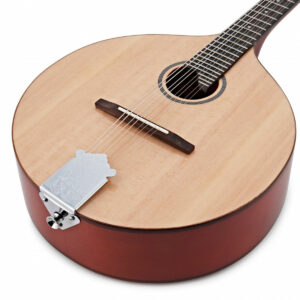 Good for beginners? No
Good for beginners? No
Genres: Country, Folk, Bluegrass, Blues, Classical
We’re rounding off our guitar types guide with a selection of acoustics that sometimes fall under the “folk” instrument category. These are:
- Mandolin
- Banjo
- Harp guitar
- Lap steel/pedal steel
These produce a wide variety of sounds, so guitarists generally purchase one if they’re interested in a particular sound.
Mandolins are small, compact instruments with paired strings, in the same vein as a 12-string acoustic. The four pairs of strings and small sound chamber create a bright, treble-focused voice that can easily cut through a mix.
The well-known banjo instantly puts you in mind of country. Its sweet, jangly tone and rapid riff-ability cover everything from Dixieland jazz to modern rock – far more than its country roots might suggest! So, look beyond the gang of murderous hillbillies in Deliverance, where the famous duelling banjos song originated, and see how it can fit around your favourite genre!
Harp guitars take the instrument in a whole new direction. In the same manner as a double-necked electric, this peculiar instrument fuses a harp and a nylon-stringed acoustic to give an extended frequency range. Boasting sweet, mellow tones and beautiful soundscapes, the harp guitar is a wonderful tool for adventurous players.
Lap steel/pedal guitars offer an alternative way of playing the strings. Both lay flat, with lap steels fitting on your, well, lap and pedal steels mounted on dedicated tables. Lap steels tend to be small and compact and played with a slide or flatpick. Pedal steels feature small levers that allow you to change the pitch of strings while playing, opening up a huge variety of sonics to explore.
How to choose the right style for you
That’s a lotta guitar we’ve just gone over, so naturally, you might still be unsure of which is right for you. Not to worry! The beauty of taking up an instrument is there are always more avenues to explore – so even if you decide you don’t like a large acoustic guitar, you might love a slinky, rock-focused electric!
The first step to finding your ideal instrument is to listen to your preferred music and identify the key sound. Partial to hard rock, blues, and other distortion-rich genres? An electric guitar will be your ideal starting point. Lover of bluegrass, country, and the bouncy tones of the banjo? Give it a try! There are plenty of banjoists out there who have never touched a standard guitar!
The chosen guitar type needs to match your preferred genre in both sound and design. You’ll struggle to shred solos on a steel-string acoustic because the neck shape, larger body, and string material will prevent you from getting the right speed and action.
And speaking of acoustics, the choice of acoustic or electro-acoustic depends on your budget and needs. In general, it’s always wiser to go for an electro-acoustic, as their wider performing and recording capabilities let you do more with the guitar.
So, in summary, the type that’s right for you will depend on your preferred sound.
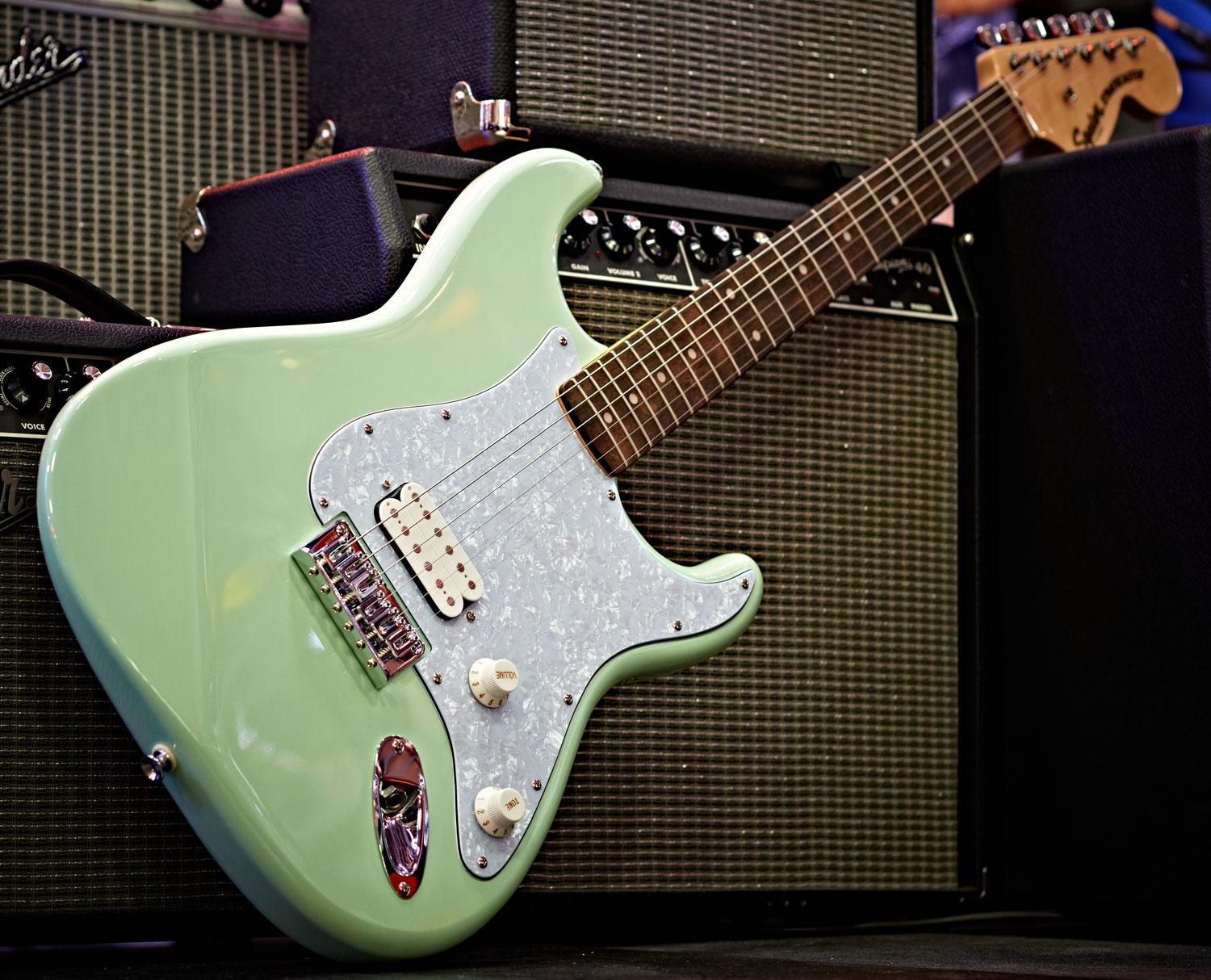
FAQs
We’ve collected some common questions about guitar types and answered the top queries.
What are the 4 main types of guitars?
The most popular and well-known types of guitars are:
- Acoustic steel strings
- Classical guitar
- Electric guitars
- Bass guitars
Which type of guitar is mostly used?
Acoustics are the most widely used guitars. They suit a number of different playing styles, have a versatile sound, and don’t require any additional equipment (such as amps) to function. Additionally, they work well both as solo instruments with vocals or as part of a mix in a larger ensemble.
Which is the best guitar for beginners?
A classical guitar is one of the best guitar types for beginners. Their smaller size, soft nylon strings, and lack of any additional equipment make them a good fit for novices. Their flat fretboards also help develop fingerpicking skills and picking accuracy.
Final thoughts
Hopefully, this meaty article has left you inspired to try out a new form of stringed instrument. If you’re a total beginner, have a look at our wide range of acoustic and electrics to get you started.
But if you want to stand out from the crowd, why not look at our daring extended-range guitars, elegant 12-string acoustics, or bright and lively ukuleles?
There are many different types of guitar to suit any style and taste, and as this article shows, if you get bored of one type, there are plenty more to try!
Happy playing!


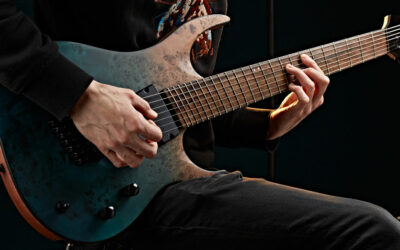
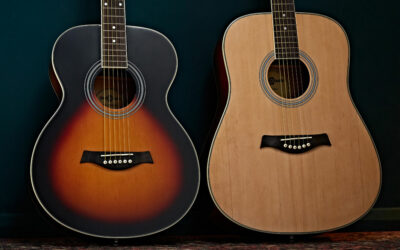

0 Comments